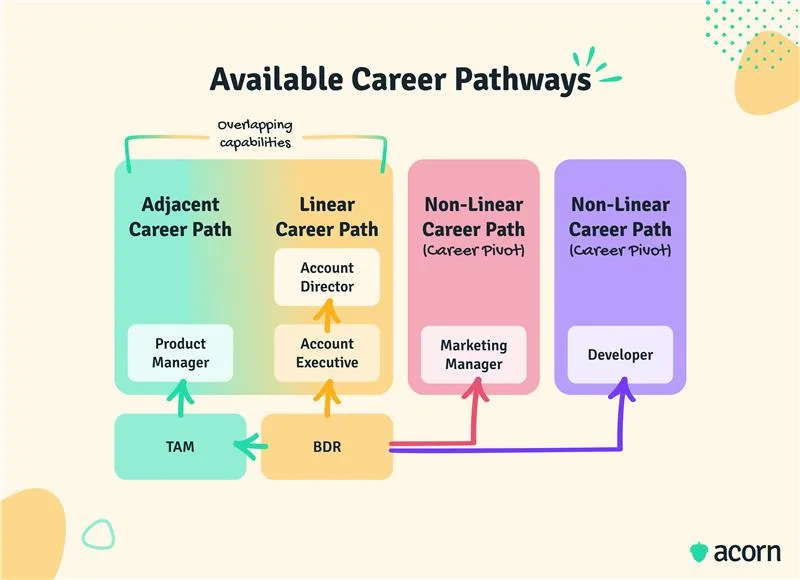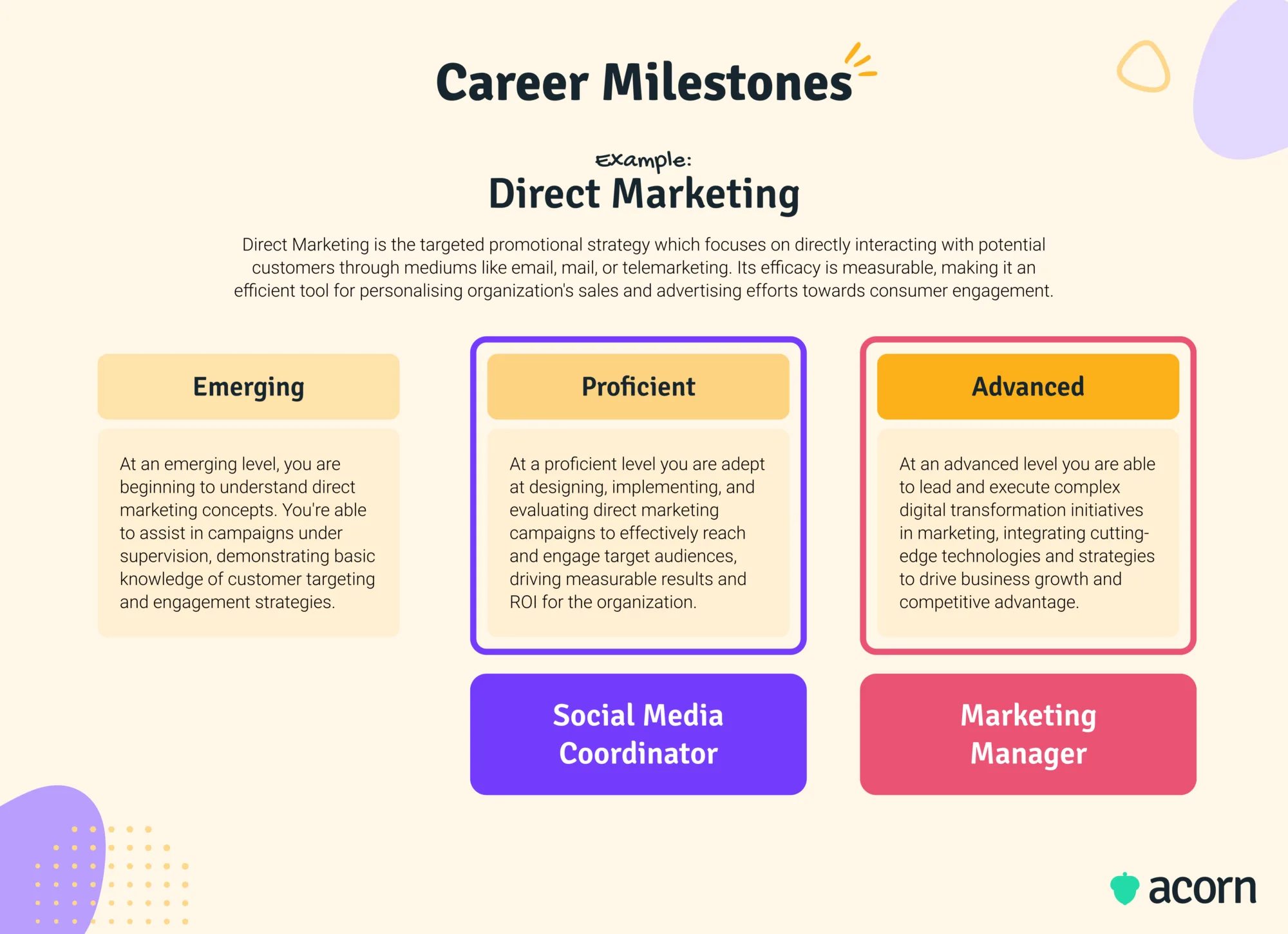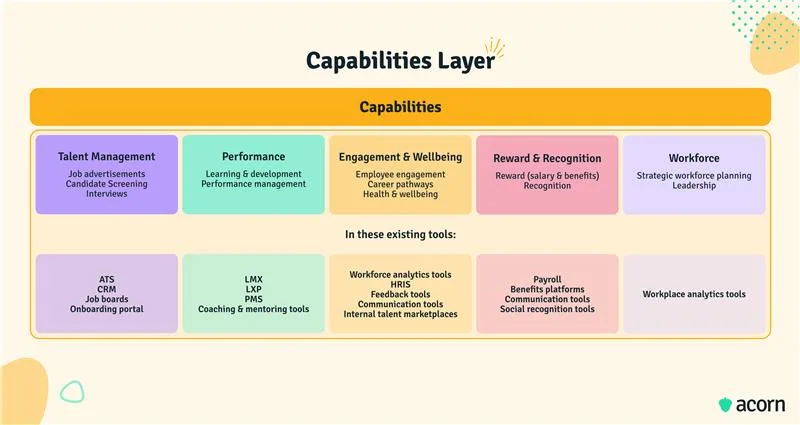How Can We Make Career Pathways Actionable at Scale?
Reading Time:

Lead the pack with the latest in strategic L&D every month— straight to your inbox.
SubscribeNot everyone wants to be a manager (and that’s perfectly fine). So, what other options are there?
Ironically, linear career progression could be holding your workforce back. According to McKinsey, a lack of career advancement is one of the highest causes of employee turnover. But that doesn’t mean you should promote people to managerial positions just so they can feel like they’re “progressing”. Traditional career ladders aren’t the answer anymore. The career lattice approach acknowledges that people can grow by becoming deeper specialists, broader generalists, or by zigzagging between departments to build unique skill combinations. Smart organizations are ditching the rigid ladder mentality and embracing these multi-directional pathways—because frankly, the best career moves often look nothing like a straight line up.
And no, you don’t have to create a whole new capability framework from scratch for this to work. It’s just a matter of scaling it with a variety of career development pathways in mind so that it doesn’t collapse under complexity.
What is a career development pathway?
Career development pathways are structured plans or frameworks that guide employees through different stages of growth within an organization. They outline the capabilities needed to progress from one role to another, whether that’s moving up a traditional career ladder, laterally into different departments, or deeper into more specialized roles.
In other words, they’re a roadmap showing where employees are now, where they could go next, and what they need to learn or do in order to get there.

Why most career progression initiatives break down at scale
Let’s be brutally honest for a moment: most professional development programs work great when you’ve got 50 employees and everyone knows everyone’s dog’s name. But try to scale that personal touch to 500, 5,000, or 50,000 employees? That’s when things get messy.
The problem isn’t that HR and L&D teams don’t care—it’s that traditional approaches to career development simply don’t scale.
Here’s what typically happens:
- Organizations either go too custom (creating unique career plans for every employee until your team burns out) or too simple (generic and irrelevant pathways to professional growth). It becomes a tug-of-war between inefficient and ineffective, rather than creating clear career paths.
- Career paths are built in a vacuum disconnected from business strategy, succession planning, and workforce capabilities. Employee development happens, but it doesn’t actually mean anything for the company’s success.
- Responsibility for career development is put entirely on managers’ shoulders, but they’re not provided with any support, training or resources to do it. They want to help their people grow, but they don’t know how, nor do they have accountability pushing them to prioritize it.
- There’s no real understanding of individual aspirations, assessing potential, or aligning personal goals with organizational needs—just generic development plans with the employee’s name at the top. It’s no different from the corporate ladder idea of career growth, and it leads to a lack of clear career paths, career stagnation, and dwindling employee engagement.
- There are no meaningful metrics to measure whether development programs are working. Sure, managers could bring it up in performance reviews, but you also lack definitions of what “good” performance looks like in practice. In the end, different departments have different ideas of what success looks like, and none of them are aligned with business needs.
How to personalize through standardization
Scaling career development isn’t about adding more to development plans until it’s too complex. It’s about standardizing the right things so you can personalize growth opportunities where it matters most.
Build your capability foundation
Your foundation is your capability framework. Your workforce capabilities are derived from business strategy, so every job role contributes to business impact in some way. Put simply, every job title needs:
- Capabilities mapped to it (we recommend five) that outline the specific actions required to do the role successfully
- Assigned proficiency levels for each capability (like foundational, developing, proficient, advanced, or expert) to indicate at what level each role needs to perform those capabilities.
These create the clear, measurable definitions of what “good” looks like at every level. Gone are the vague job descriptions that read like horoscopes (what does “you will be a detail-oriented team player” even mean?). Now you have detailed outcomes and KPIs around the skills, knowledge, behaviors, processes, and tools that drive performance, and you can differentiate performance markers between roles.
In practice, instead of saying “Sarah needs to develop leadership skills,” say “Sarah currently demonstrates foundational proficiency in team coordination and needs to develop her proficiency in strategic thinking and change management to move to the next level.” See the difference? One is a wish, the other, a roadmap.
Proficiency levels are crucial in career mobility because they can indicate career milestones. Different roles won’t have the exact same capability sets, but there might be some crossover—some roles will be expected to perform at different proficiency levels. It means your employees can see exactly where they are, where they want to go, and what capabilities they need to develop to reach the proficiency they need to get there. Where the KPIs for a junior marketer’s proficiency revolve around executing tasks (like writing X number of blogs or resources per week) the team lead’s KPIs require them to work more on content strategy and analysis.

Enable choice within structure
Here’s where the personalization magic happens. Your capability framework provides the structure, but employees get to choose their own adventure based on their ambitions. Employees will do whatever training they need to develop the capability sets for their roles, but where some want the leadership track, others prefer a scenic route through specialization. Some are ready for stretch assignments to develop their capabilities beyond what is strictly required of them; others need to build foundational skills first.
The key is building interest capabilities alongside role-required ones. Maybe someone in finance is fascinated by data science, or someone in operations wants to understand customer experience. Your employees choose what they’re interested in learning (even if it’s not directly tied to their current role) and then your system can suggest relevant development opportunities using AI.
A lot of organizations struggle with a lack of employee engagement in learning, and giving employees opportunity to develop areas that interest them does wonders for their motivation. If employees get the professional and personal growth they desire, employee retention improves. Their interest in learning means shorter time to proficiency and that top talent is ready to take the next step towards their career goals.
Make L&D capability-led
Capability-led learning is the key here, not skills development or generic training. Skills don’t work on their own anyway, because they’re too changeable; with their half-life shrinking below four years thanks to new tech and AI.
And generic one-time or one-size-fits-all training courses for everyone in your company is irrelevant to employees’ everyday work because:
- It’s a bit of an afterthought, and
- It’s treated like a check-box exercise.
Instead of offering professional development just to say you did it or throwing a bunch of training programs at the wall hoping something sticks, design learning experiences around specific capability gaps. Use capability assessments to identify where people are, AI to suggest relevant development opportunities, and provide real-world scenarios for knowledge application.
This creates a feedback loop: capabilities define what people need to learn, assessments show where they are, and experiences help them grow. No more random training catalogs that look like Netflix for corporate learning but with worse recommendations.
Turn managers into growth enablers
Continuous learning can’t happen on its own—it needs direction from the top. And given managers are responsible for 70% of employee engagement, there’s a lot riding on their shoulders.
Managers aren’t mind-readers or career counsellors—they need the tools and accountability to coach their people. Career development is part of their job, so setting expectations around that begins with how you talk about performance and capabilities, and giving them access to technology that makes them growth enablers (more on that below).
One of our product designers expressed interest in designing learning modules. Using our Capabilities platform, their manager was able to:
- Evaluate their current capabilities
- Review the required capabilities or the role they wanted
- Determine that there were crossover capabilities between the roles
- Create a development plan tailored to the learner’s specific capability gaps.
The employee got their career development plan, worked on the relevant training, and came out the other end ready to use their new capabilities. When managers are trained in capability building, career planning conversations go from “maybe we can talk about that next quarter” to “let’s look at your capability gaps and figure out your next growth opportunity.” This is what pivots them into coaching, rather than blocking, employee career paths.
Let technology do the heavy lifting
Did you know that 36% of organizations still use spreadsheets or other manual tracking methods to manage, track, and assess capabilities? Or that a lot of organizations don’t get capability programs off the ground because the first step—building a capability framework—is so time-consuming and resource-intensive?
Build your own capability framework using our Capability AI Assistant!
There’s an answer to that: technology. Use technology to:
- Build your capability framework
- Trigger development opportunities
- Track development plan progress
- Evolve career paths based on changing business needs and individual growth
- Suggest stretch assignments (like setting more analytical tasks for junior employees) based on capability gaps
- Nudge employees toward relevant learning opportunities
- Help managers spot development needs before they become performance issues.
We use our own Capabilities platform for this, which centralizes and analyses everything using AI. You wouldn’t need to manually track all these moving parts—when they’re being tracked for you, all you need to do is take action.
Capabilities themselves have tangible metrics for each proficiency level rather than evaluating performance based on vibes, which removes a lot of room for human error. Technology can take it a step further by not only keeping all that performance data in once place, but also recommending further development for high-performing employees. It means those biases that we may not know we have are put aside, and everyone gets career opportunities based on merit.
This enhances human connection but doesn’t replace it. The best career development happens through relationships, mentoring, and meaningful experiences—technology just makes it easier to scale and track. A platform like Capabilities helps managers can see how employees were performing before and how their performance has changed since completing training, based on how employees’ proficiency improves in their next capability assessments.
Integrate everything (yes, everything)
Your capability framework should sit across your entire HR stack, talking to your talent management, performance management, employee wellbeing, reward and recognition, and workforce planning strategies. When these systems are integrated, career development becomes part of organizational DNA rather than a separate initiative.

This integration also solves the measurement problem we talked about earlier. You can track capability progression, time-to-proficiency by role, internal mobility rates, and career velocity—all because you have a common language and shared definitions of growth.
Let’s say a marketing coordinator wants to become a product marketing manager. A capability framework integrated with a talent management system can identify the capabilities she possesses and where that might make her a good candidate for career advancement into the role she wants. Integrated with performance and learning management tools and reward and recognition initiatives, she can improve her capabilities through suggested training, track her performance towards career goals, and determine whether she’s being accurately compensated for her contributions. And with workforce analytics, you can see where there may be opportunities for professional growth in the future in line with industry trends or organizational strategy.
Final thoughts
The future of career development isn’t about building higher ladders—it’s about helping people build the careers they actually want, one rung, swing, or sideways shuffle at a time. Your employees want growth opportunities that match their individual aspirations, whether that’s becoming a senior specialist, switching departments, or taking on stretch assignments that build new capabilities and opportunities.
You can standardize the infrastructure while tailoring career development programs using AI without losing a human touch. Your employees get the personalized growth they crave, your managers get the support they need, and your organization gets the engaged, developing workforce it deserves.